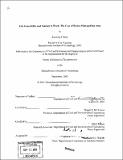Job accessibility and journey to work : the case of Boston Metropolitan area
Author(s)
Chung, Jee-seong, 1969-
DownloadFull printable version (17.46Mb)
Other Contributors
Massachusetts Institute of Technology. Dept. of Civil and Environmental Engineering.
Advisor
Nigel H.M. Wilson and Mikel Murga.
Terms of use
Metadata
Show full item recordAbstract
In this study, variations in levels of transit usage to work from block groups in the Boston metropolitan area were explored. The examination of the 2000 Census data showed that there were significant differences in the transit share of the work trip at the block group level. In order to understand this variation, which is required to plan and implement transportation policy in the region, the study area was categorized into three groups based on the level of relative job accessibility. Commuting patterns in these areas were examined and compared to each other. First, the conceptual and measurement issues surrounding accessibility are reviewed. Next, travel time impedance functions were developed using the journey to work data from Census Transportation Planning Package (CTPP) 2000, considering both transit and auto travel time between all origin-destination pairs in the Boston Metropolitan area thanks to the Central Transportation Planning Staff (CTPS), the transportation network data from Massachusetts Geographic Information Systems (MassGIS), and the job location data from Initiatives for a Competitive Inner City (ICIC). (cont.) Then, job accessibility by auto and transit were calculated based on a hypothesis that job accessibility is an important factor in determining transit mode share from both residential and workplace perspectives. Finally, the spatial robustness of the general trip distribution was examined using GIS to compare mode choice behavior in block groups with different land use characteristics: block groups in the high relative job accessibility areas, block groups in the low relative job accessibility areas, and block groups in the entire study area. The comparison led to the conclusion that it is unrealistic to think that simple models such as those developed earlier in this research could be generally applied to all block groups in the metropolitan area. The geographical analyses suggested that a disaggregate approach should be applied not only to data collection (e.g., collecting individual survey data) but also to developing mode split models in order to improve their explanatory power.
Description
Thesis (S.M.)--Massachusetts Institute of Technology, Dept. of Civil and Environmental Engineering, 2005. Includes bibliographical references (leaves 106-109).
Date issued
2005Department
Massachusetts Institute of Technology. Department of Civil and Environmental EngineeringPublisher
Massachusetts Institute of Technology
Keywords
Civil and Environmental Engineering.